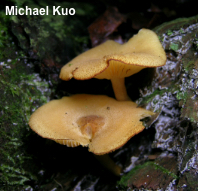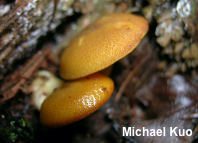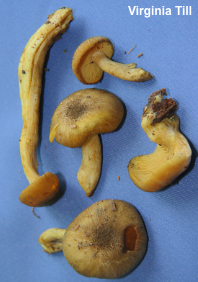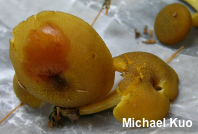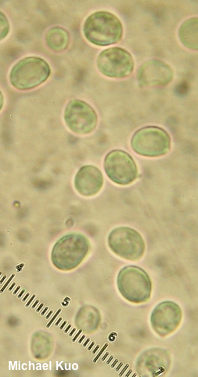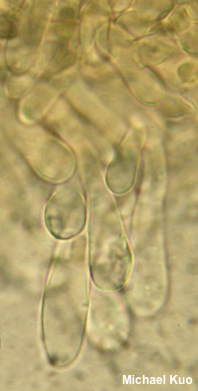| Major Groups > Gilled Mushrooms > Pale-Spored > Collybioid > Tricholomopsis decora |

|
Tricholomopsis decora [ Basidiomycota > Agaricales > Tricholomataceae > Tricholomopsis . . . ] by Michael Kuo There may be several North American species going under the European name "Tricholomopsis decora," but for the present they are perhaps best treated as a species group, characterized by the ecology (decaying the wood of conifers), the yellow colors, and the fine brownish scales covering the cap surface, especially toward the center. The spore print is white, and a drop of KOH on the cap surface produces a pink to red reaction. Similar species include Tricholomopsis sulphureoides (with yellow scales and brighter yellow colors overall), Tricholomopsis thompsoniana (with a bald cap), and Tricholomopsis bella (cap fibrillose but not truly scaly). One contemporary DNA study (Olariaga and collaborators 2015) revealed separation between Tricholomopsis decora collections from North America and from Europe; further research may determine whether the separation justifies treatment of two (or more) species. Description: Ecology: Saprobic on the wood of conifers, especially (but not exclusively) that of hemlocks; growing alone, scattered or gregariously; summer and fall; widely distributed in North America; also known from Europe and Australasia. The illustrated and described collections are from Colorado, Kentucky, and Ohio. Cap: 2–5 cm; convex at first, becoming broadly convex, flat, or shallowly depressed with an uplifted margin; moist when young but soon dry; yellow to brownish yellow; covered, at least over the center, with small brownish to grayish scales and fibrils. Gills: Broadly attached to the stem; close or crowded; yellow to brownish yellow; short-gills frequent. Stem: 2–5 cm long; 3–6 mm thick; more or less equal; bald; hollow; pale yellow; basal mycelium white. Flesh: Yellowish; not changing when sliced. Odor and Taste: Odor not distinctive; taste bitter. Chemical Reactions: KOH red to pink or orange on cap surface. Spore Print: White. Microscopic Features: Spores 4–8 x 4–6 µm; broadly ellipsoid to subglobose; smooth; hyaline in KOH; inamyloid. Lamellar trama parallel. Basidia 4-sterigmate. Pleurocystidia not found. Cheilocystidia 50–62.5 x 10–15 µm; cylindric to subclavate; smooth; thin-walled; hyaline in KOH. Pileipellis a cutis; elements sometimes agglutinated, 3–10 µm wide, smooth, golden in KOH en masse (individually yellowish)—interspersed with bundles of uplifted brown elements (the scales); clamps present. REFERENCES: (Fries, 1821) Singer, 1939. (Saccardo, 1887; Smith, 1949; Smith, 1960; Smith, 1975; Smith, Smith & Weber, 1979; Breitenbach & Krãnzlin, 1991; Phillips, 1991/2005; Lincoff, 1992; Barron, 1999; Boekhout & Noordeloos, 1999; McNeil, 2006; Bougher, 2009; Trudell & Ammirati, 2009; Olariaga et al., 2015; Saar & Voitk, 2015; Siegel & Schwarz, 2016; Baroni, 2017; Holec, 2018; Sturgeon, 2018; Læssøe & Petersen, 2019.) Herb. Kuo 10010402, 07281202. Herb. DBG CMS2011. This site contains no information about the edibility or toxicity of mushrooms. |
© MushroomExpert.Com |
|
Cite this page as: Kuo, M. (2020, February). Tricholomopsis decora. Retrieved from the MushroomExpert.Com Web site: http://www.mushroomexpert.com/tricholomopsis_decora.html |

